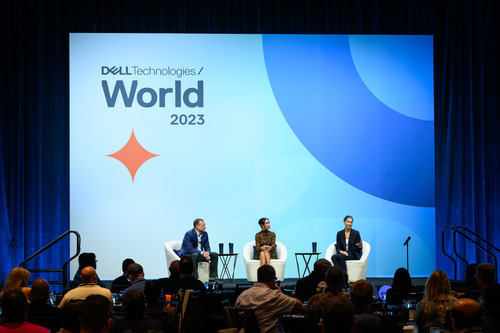
From AI to cryptocurrency to immersive tech experiences, tech has come incredibly far in just the last 20 years. How has the tech industry fostered such a forward-thinking environment, and are there any downsides to the massive leaps in tech we see today?
At the 2023 Dell Technologies World conference, Dell CTO John Roese sat down with tech futurists Sinead Bovell and Samantha “Sam Rad” Radocchia to talk about the breakthrough ideas that are slated to disrupt industries and communities…for better or for worse.
Bovell, the founder of tech education company WAYE, is a proponent of preparing young people for a future guided by advanced tech by applying ethical landscapes and frameworks to emerging technologies. With a background in science and business, she founded WAYE to foster conversations around the ever-changing digital landscape and its potential impact on our daily lives.
Radocchia is a four-time entrepreneur and the founder of meta-media studio Radical Next which guides companies to envision radical new ideas and technologies and to build strategies and experiences that will usher businesses through times of radical change. An early pioneer in virtual realities, AI, and blockchain, Radocchia holds several patents focused on linking the digital and physical worlds.
During their discussion with Roese, Bovell and Radocchia shared their perspectives on disruptive tech, championing and cautioning Dell Tech World attendees about the expanding responsibilities of the tech community at the forefront of progress.
Generative AI: Creating content or chaos?

From ChatGPT to DALL-E, generative artificial intelligence has taken culture by storm. If your Instagram feed wasn’t clogged with fantastical photo-generated portraits of your friends made by the Lensa AI app in late 2022, you may have heard news stories of the problematic workarounds students have taken by entrusting AI bots to write essays and complete homework. Generative AI uses machine learning to create audio, images, code, and more.
According to McKinsey & Company, the amount of data ingested by these algorithms far surpasses human capacity, but there is, of course, human direction that informs the kinds of data this technology processes. “These systems decode and expand on our imaginations of whatever is possible,” said Bovell during the session. “[Humans] have a narrow context of what we can extract from a piece of information, but AI takes a multi-modal approach, where we can give it a picture, and it comes back with a formula for a medication.” By identifying patterns within the information received, AI can predict outcomes, scour its massive reserves of data for solutions, and even create net-new content based on prompts or questions.
Beyond its impact on social media timelines, generative AI has massive implications for the medical field, climate change science, business and more. “It’s beyond a static thing that you’re consuming, but rather an existing system or set of systems that are working with us, alongside us, in our offices, in our daily lives, in our societies,” said Radocchia. Bovell added, “We may look at an image of an fMRI scan or a brain scan and have kind of a narrow context of what we can extract from it, versus an AI decoding the meaning of that image.” Generative AI has already been put to work generating medical diagnoses and treatment plans, as in the case of Glass.Health, and optimizing business decisions in the C-suite.
However, experts warn of the risks of adopting these tools without regulation. “We’re entering into an era where video, audio and text may no longer be synonymous with choice,” cautioned Bovell. “We really do need to think critically about what are the guardrails that we want to place on this next evolution of technology.
How can we do this safely?” Without the proper governance, AI can be used to promote generated content as factual, leading to eroded public trust and confidence in false conclusions. From incorrect search results to a medical formula gone wrong, machine learning is only as good as the data it’s fed and the intentions of those doing the feeding.
As the technology becomes more commonplace, international governments are doing their best to implement regulations. According to The Brookings Institution, the European Union and United States governments have developed diverging strategies to manage the growing use of AI. While the E.U. has put forth legislation that impacts specific digital environments and encourages public transparency, the U.S. has invested in non-regulatory practices distributed across federal agencies that are risk-based and sector-specific. “You can’t wait five years and say, ‘Who’s going to govern this new era of ubiquitous computing of fully immersive realities that we’re designing?’” asked Radocchia.
Tech gets deep(er)
Immersive realities, or artificial environments that give users the impression of being physically present in a digital world, are one of the fastest-growing focus areas for companies over the last decade. Dell’s 2023 Innovation Index reported that 33% of innovative companies have made investments in immersive and mixed-reality technology. These synthetic experiences are built as a collective shared space and can be used as platforms for business, discourse and culture. Immersive realities build upon the original value prop of message boards and social media to bring people, platforms and programs together. “The internet of the future is not characterized by the number of people on devices,” said Roese. “It’s connected by the number of entities, and most of those are likely to be virtual entities: AI-driven systems and capabilities. We need to start thinking about them as participants in our experience.“
As with generative AI, mixed realities have the potential to blur the lines between truth and fiction. However, the immersive nature of most metaverse technology offers a new wrinkle to how humans experience the digital world. “We’re getting to a point where data is coming in not only through our combination of the five senses but also this kind of unspoken connection that we share,” said Radocchia.

“When we’re talking about human biology, the combination of that and artificial intelligence is going to end in a place where people can tap into these other realms like machines, and we’re going to start to see the blurring of the very nature of what’s real.”
“The more immersive the technologies are, the more biological data will be fed into systems that can reinforce those experiences,” said Bovell. “When people talk about the metaverse, it’s less of a place we go or an experience we step into, and more of the next evolution of the infrastructure of technology.”
Powering tools like AI and mixed realities is quantum computing, which has laid the groundwork for future technology. By harnessing the laws of quantum mechanics, scientists and developers have created super-charged processors that are able to produce answers for complex problems at rates far beyond the capabilities of classic computers while using less energy. From electric vehicles to supply chain solutions, quantum computing is already being implemented at the highest levels of the most innovative organizations—and not a moment too soon. Experts have warned the tech industry about the imminent arrival of Q-Day, or when quantum computers will be able to crack encryption algorithms and will therefore render digital infrastructure vulnerable.
Preparing for what’s next
As the march of innovation moves ever forward, it’s imperative that users and consumers have the skill set to engage with technologies carefully and ethically. Bovell’s tech-ed company WAYE hosts talks geared towards young professionals and entrepreneurs that aim to foster conversations about how digital shifts intersect with business, and how that will impact them in the future. With a focus on minority and non-traditional markets, WAYE Talks are structured to allow for a spotlight on new perspectives, with an educational tilt that will serve participants as they move into the workforce.
Dell’s Innovation Index looked at what practices the most impactful and innovative companies are taking as they deal with the impact of new technology. From the boom in sustainability initiatives to building community through hackathons and scrums, companies are getting more strategic just as technology is showing how smart it has the potential to be. “We are going to have to develop both sides of the coin when it comes to working with AI,” said Bovell. “The reality is we are stepping into a world where humans are no longer the smartest system in the room for every decision.”
“I think that there’s a role for us in the future to preserve our more esoteric, human knowledge,” said Radocchia. “The AI systems will come to teach us, and certainly we can learn, but there are also softer skills that have not historically been valued as much that will be valued more.” Working alongside emerging technologies, users have the opportunity to further the field of inclusive design beyond its current definition. By imparting our particular brand of human knowledge and empathy, we can responsibly impact the future while achieving the unthinkable.


